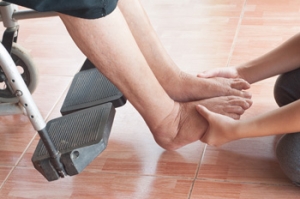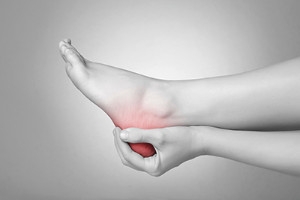Connect With Us

How Do Stress Fractures Affect the Feet?
 A stress fracture is a small hairline fracture that is a result from overuse. The feet are particularly susceptible to developing stress fractures and there are a variety of different types. One of the most common foot stress fractures is a navicular stress fracture. This occurs on the top of the midfoot and is common in sprinters and jumpers. Another type of stress fracture is a metatarsal stress fracture which occurs along one of the metatarsal bones. A metatarsal stress fracture can develop from overuse or poor foot biomechanics and the pain is usually felt towards the middle, or front of the foot and worsens with weight bearing activities. A calcaneal fracture occurs in the heel bone and is common among soldiers who march frequently, as well as runners who choose to do their running on the road. Another common stress fracture that may occur in the feet is a Jones fracture which occurs in the 5th metatarsal and causes pain on the outside of the foot. If you are experiencing pain in the foot, it may be the result of one of these stress fractures. Consult with a podiatrist for a proper diagnosis and plan for treatment.
A stress fracture is a small hairline fracture that is a result from overuse. The feet are particularly susceptible to developing stress fractures and there are a variety of different types. One of the most common foot stress fractures is a navicular stress fracture. This occurs on the top of the midfoot and is common in sprinters and jumpers. Another type of stress fracture is a metatarsal stress fracture which occurs along one of the metatarsal bones. A metatarsal stress fracture can develop from overuse or poor foot biomechanics and the pain is usually felt towards the middle, or front of the foot and worsens with weight bearing activities. A calcaneal fracture occurs in the heel bone and is common among soldiers who march frequently, as well as runners who choose to do their running on the road. Another common stress fracture that may occur in the feet is a Jones fracture which occurs in the 5th metatarsal and causes pain on the outside of the foot. If you are experiencing pain in the foot, it may be the result of one of these stress fractures. Consult with a podiatrist for a proper diagnosis and plan for treatment.
Stress fractures occur when there is a tiny crack within a bone. To learn more, contact Charles Passet, DPM from Forest Hills. Our doctor can provide the care you need to keep you pain free and on your feet.
How Are They Caused?
Stress fractures are the result of repetitive force being placed on the bone. Since the lower leg and feet often carry most of the body’s weight, stress fractures are likely to occur in these areas. If you rush into a new exercise, you are more likely to develop a stress fracture since you are starting too much, too soon. Pain resulting from stress fractures may go unnoticed at first, however it may start to worsen over time.
Risk Factors
- Gender – They are more commonly found in women compared to men.
- Foot Problems – People with unusual arches in their feet are more likely to develop stress fractures.
- Certain Sports – Dancers, gymnasts, tennis players, runners, and basketball players are more likely to develop stress fractures.
- Lack of Nutrients – A lack of vitamin D and calcium may weaken the bones and make you more prone to stress fractures
- Weak Bones – Osteoporosis can weaken the bones therefore resulting in stress fractures
Stress fractures do not always heal properly, so it is important that you seek help from a podiatrist if you suspect you may have one. Ignoring your stress fracture may cause it to worsen, and you may develop chronic pain as well as additional fractures.
If you have any questions, please feel free to contact our office located in Forest Hills, NY . We offer the newest diagnostic and treatment technologies for all your foot care needs.
Stress Fractures of the Foot and Ankle
Our bones are important aspects of our body and they are constantly changing. The heavier the workload for a bone, the more likely it is that calcium will be placed in it. When a bone isn’t used often, there won’t be much calcium within it. When stress from repetitive loads prevent the bone from being able to repair itself, cracks will start to form. Stress fractures are defined as cracks in a bone that result from repetitive force, such as overuse.
The most common cause of stress fractures is a sudden increase in intensity and duration of physical activity. For example, if you begin to run long distances without working your way into doing so, you will be more likely to develop a stress fracture.
Common symptoms of stress fractures are pain and swelling near the weight bearing area on the injured bone. When initial x-rays are performed, it is possible that the fracture will not show up. However, once the stress on the area continues, the damage will increase, and the fracture will be severe enough to show up on an x-ray. Certain parts of the foot are more likely to develop stress fractures than others. Areas that typically have these fractures are: the metatarsals, the navicular bone, the calcaneus, tibia, and fibula.
Since women are at an increased risk of developing osteoporosis, they are twice as likely as men to sustain a stress fracture. Additionally, old age causes a decrease in bone mineral density which is why elderly people are also likely to develop these fractures.
It is important for you to be professionally diagnosed by a podiatrist if you suspect you have a stress fracture, because there are other injuries that can easily be mistaken for a fracture. Sprains, strains, shin splints, plantar fasciitis, and Morton’s neuroma can all easily be mistaken for stress fractures in the foot. Your podiatrist will likely ask you a series of questions to determine what type of pain you are experiencing. These questions will help your doctor identify whether you have a stress fracture.
The best method of treatment for a stress fracture is rest. Additionally, a walking boot, cast, or crutches, will help rest the area that is injured. The typical healing time for stress fractures is 4-12 weeks, however this depends on which bone is involved.
Lower Limb Swelling in the Elderly
Older adults often deal with swelling, or edema, in the feet and ankles. Edema occurs when fluids from blood vessels move into the spaces between cells near the surfaces of the feet and ankles. Common causes of lower limb edema include chronic venous insufficiency, congestive heart failure, certain medications, liver disease, kidney disease, or lymphedema. New or worsening swelling in the lower limbs should be evaluated by a doctor, especially if you also experience pain that limits your mobility or interferes with daily activities. If the cause of your swelling is chronic venous insufficiency, which is very common, it may help to elevate the legs, reduce salt intake, wear compression stockings, or exercise the calf muscles. To learn more about elderly foot care, please consult with a podiatrist.
Proper foot care is something many older adults forget to consider. If you have any concerns about your feet and ankles, contact Charles Passet, DPM from Forest Hills. Our doctor can provide the care you need to keep you pain-free and on your feet.
The Elderly and Their Feet
As we age we start to notice many changes in our body, but the elder population may not notice them right away. Medical conditions may prevent the elderly to take notice of their foot health right away. Poor vision is a lead contributor to not taking action for the elderly.
Common Conditions
- Neuropathy – can reduce feeling in the feet and can hide many life-threatening medical conditions.
- Reduced flexibility – prevents the ability of proper toenail trimming, and foot cleaning. If left untreated, it may lead to further medical issues.
- Foot sores – amongst the older population can be serious before they are discovered. Some of the problematic conditions they may face are:
- Gouging toenails affecting nearby toe
- Shoes that don’t fit properly
- Pressure sores
- Loss of circulation in legs & feet
- Edema & swelling of feet and ankles
Susceptible Infections
Diabetes and poor circulation can cause general loss of sensitivity over the years, turning a simple cut into a serious issue.
If you have any questions please feel free to contact our office located in Forest Hills, NY . We offer the newest diagnostic and treatment technologies for all your foot and ankle needs.
Elderly and their Feet
While proper foot care is important for everybody, senior citizens have the tendency to be more susceptible to certain foot conditions. The elderly should therefore be well informed about any problems that may arise and about what they can do to properly avoid or treat them.
Some of the most common foot problems seniors are susceptible to include foot ulcers, ingrown toenails, fallen arches, and fungal nails. A foot ulcer is an open sore on the foot and can be a result of diabetes and decreased sensation in the feet. An ingrown toenail is defined as when the nail grows into the side of the toe. Fallen arches are indicated by the instep of the foot collapsing. A fungal nails is a condition that results in deformed and discolored toenails.
In order to avoid these conditions it is recommended that the feet be inspected by the patient on a regular basis. If these inspections are carried out routinely, there is a good likelihood that problems can be identified before they become severe, or can even be avoided altogether. If any abnormality is discovered, it is important that the individual consult a podiatrist for diagnosis and information on treatment options.
Proper foot hygiene is also important. Making sure that you always have clean, dry socks on can be a major deterrent to many different problems including bacterial infections, foot odor, and certain types of fungus. Wet feet are a major cause of many of these problems. If your socks get wet, it is important to change them. Walking around in wet socks may not only lead to various infections, but can irritate the skin and result in a number of various complications. Clean, dry feet are less likely to be affected by fungal and other infections.
As people age, the fat present on your feet begins to deteriorate. The protective nature of this fat keeps the feet healthy by providing a barrier between your bones and the ground. This also aids in giving the skin on the feet a certain amount of elasticity. This is one factor that causes elderly people to develop some serious foot issues. Foot moisturizers can be helpful to avoid certain problems associated with this. However, water-based moisturizers do not work as well for elderly people as they do for the young. Instead, it is more effective to use an emollient instead. An emollient is effective because it binds the water in the foot, keeping it from becoming absorbed too readily which will result in dry skin. Emollients also have a special property called occlusion, which provides a layer of oil on the skin. This layer prevents the foot from drying up and can be very effective in treating dry skin disorders. If you can keep the skin on your feet healthy, this will substantially reduce the number of foot problems you will encounter in old age.
Proper footwear is another way to keep feet healthy. Shoes that fit well and provide proper support help prevent ingrown toenails and fallen arches.
Certain medical conditions such as diabetes or poor blood circulation increase the risk for foot issues. For individuals with any of these conditions it is extremely important to conduct regular foot inspections to make sure that there are no sores or infections present.
Common Foot Injuries Among Dancers
Dance is an intense sport that can be particularly hard on the feet. Dancers are prone to a variety of foot and ankle injuries. Fifth metatarsal fractures, also known as dancer’s fractures, occur when the fifth metatarsal bone along the outside of the foot is broken. A dancer may incur this injury after making a bad landing from a jump. Sesamoiditis, an overuse injury, causes pain under the big toe. Bunions, which are bony growths located at the base of the big toe joint, are common among both dancers and in the general population. However, dancers often develop bunions at earlier ages than non-dancers. Other foot and ankle injuries that a dancer is at risk for include hallux rigidus, plantar fasciitis, metatarsalgia, and Achilles tendonitis. If you are a dancer, it is recommended that you see a podiatrist regularly. This specialist can diagnose and treat your foot problems as well as offer advice on preventive measures against injury.
Sports related foot and ankle injuries require proper treatment before players can go back to their regular routines. For more information, contact Charles Passet, DPM of Forest Hills. Our doctor can provide the care you need to keep you pain-free and on your feet.
Sports Related Foot and Ankle Injuries
Foot and ankle injuries are a common occurrence when it comes to athletes of any sport. While many athletes dismiss the initial aches and pains, the truth is that ignoring potential foot and ankle injuries can lead to serious problems. As athletes continue to place pressure and strain the area further, a mild injury can turn into something as serious as a rupture and may lead to a permanent disability. There are many factors that contribute to sports related foot and ankle injuries, which include failure to warm up properly, not providing support or wearing bad footwear. Common injuries and conditions athletes face, including:
- Plantar Fasciitis
- Plantar Fasciosis
- Achilles Tendinitis
- Achilles Tendon Rupture
- Ankle Sprains
Sports related injuries are commonly treated using the RICE method. This includes rest, applying ice to the injured area, compression and elevating the ankle. More serious sprains and injuries may require surgery, which could include arthroscopic and reconstructive surgery. Rehabilitation and therapy may also be required in order to get any recovering athlete to become fully functional again. Any unusual aches and pains an athlete sustains must be evaluated by a licensed, reputable medical professional.
If you have any questions please feel free to contact our office located in Forest Hills, NY . We offer the newest diagnostic and treatment technologies for all your foot and ankle needs.
Sports Related Foot And Ankle Injuries
Foot and ankle injuries are common among people who participate in sports. Several factors contribute to this. They include failing to stretch or warm up properly, not wearing the proper type of shoe and not taping or providing other types of support for the ankle or foot. The most common foot and ankle injuries suffered by people involved in sports are plantar fasciitis, ankle sprains and Achilles tendon damage or ruptures. If not treated properly, they can lead to permanent disability.
Treating these injuries is relatively simple if they are identified and addressed early. Many athletes dismiss the initial aches and pains associated with injury as just soreness or tired muscles. Their first response is usually to try to work through it. This can lead to serious problems. Many minor injuries are made far more serious when athletes continue to put strain and pressure on them. That attitude can change a mild strain into a serious strain and a minor tear into a rupture. Athletes should have unusual aches and pains evaluated by a skilled medical professional.
Plantar fasciitis is a painful injury. It is inflammation of the plantar fascia, the thick band of tissue running from the heel to the base of the toes. If left untreated, it can lead to a degenerative disease called plantar fasciosis. There are several effective treatments for this ailment. Doctors often prescribe rest, massages, stretching, night splints, physical therapy, anti-inflammatory medication, corticosteroids or surgery, usually in that order. The most effective treatment for plantar fasciitis is orthotics, which offers foot support. Surgery is occasionally used as a last resort, but it comes with the risk of nerve damage and infection and often does not stop the pain.
The Achilles tendon is the largest tendon in the body. It connects the calf muscles to the heel bone. Running, jumping and walking all impact this tendon. Two common injuries to the Achilles tendon are tendonitis and a rupture of the tendon. Tendonitis is inflammation in the tendon often caused by an increase in the amount of stress placed on it. Non-surgical treatments include rest, ice or anti-inflammatory medication. A rupture (tear) of the Achilles tendon can be treated by placing the lower leg in a cast for several weeks or with surgery. Many physicians feel surgery is the better option because it lowers the risk of re-ruptures. Both methods require 4 to 6 months of rehabilitation.
Ankle sprains are the most common sports related foot and ankle injury. A sprain occurs when the ligament holding the ankle bones and joint stretches beyond its normal range. It can be treated non-surgically with a combination of rest, ice wrapped around the joint for 30 minutes immediately after injury, compression by a bandage and elevating the ankle above the heart for 48 hours. This combination is referred to as RICE. Severe ankle sprains in which the ligaments are torn may require reconstructive surgery followed by rehabilitation.
Pain in the Back of the Heel
 There are various reasons why heel pain can occur in the back of the heel. These can include Achilles tendonitis, bursitis, and heel spurs. The former affects the tendon that is attached to the heel bone, and pain may happen if there are small tears in it. This can occur from an injury, or from overuse. Bursae is found behind the heel bone, and pain may occur if they become irritated. A heel spur is defined as a small bony protrusion that forms on the outside of the heel bone. It gradually develops, and can cause pain and discomfort. Heel pain can indicate several serious foot conditions, and it is suggested that you confer with a podiatrist who can diagnose, treat, and manage heel pain.
There are various reasons why heel pain can occur in the back of the heel. These can include Achilles tendonitis, bursitis, and heel spurs. The former affects the tendon that is attached to the heel bone, and pain may happen if there are small tears in it. This can occur from an injury, or from overuse. Bursae is found behind the heel bone, and pain may occur if they become irritated. A heel spur is defined as a small bony protrusion that forms on the outside of the heel bone. It gradually develops, and can cause pain and discomfort. Heel pain can indicate several serious foot conditions, and it is suggested that you confer with a podiatrist who can diagnose, treat, and manage heel pain.
Many people suffer from bouts of heel pain. For more information, contact Charles Passet, DPM of Forest Hills. Our doctor can provide the care you need to keep you pain-free and on your feet.
Causes of Heel Pain
Heel pain is often associated with plantar fasciitis. The plantar fascia is a band of tissues that extends along the bottom of the foot. A rip or tear in this ligament can cause inflammation of the tissue.
Achilles tendonitis is another cause of heel pain. Inflammation of the Achilles tendon will cause pain from fractures and muscle tearing. Lack of flexibility is also another symptom.
Heel spurs are another cause of pain. When the tissues of the plantar fascia undergo a great deal of stress, it can lead to ligament separation from the heel bone, causing heel spurs.
Why Might Heel Pain Occur?
- Wearing ill-fitting shoes
- Wearing non-supportive shoes
- Weight change
- Excessive running
Treatments
Heel pain should be treated as soon as possible for immediate results. Keeping your feet in a stress-free environment will help. If you suffer from Achilles tendonitis or plantar fasciitis, applying ice will reduce the swelling. Stretching before an exercise like running will help the muscles. Using all these tips will help make heel pain a condition of the past.
If you have any questions please contact our office located in Forest Hills, NY . We offer the newest diagnostic and treatment technologies for all your foot and ankle needs.
Heel Pain
Have you ever gotten up from a chair or out of bed in the morning, and upon taking that first step, feel like your heel has stepped on a tack? Many people experience a feeling of sharp pain which radiates into their arch from their heel and which does not allow them to put their heel on the floor. Sometimes they need to sit back down, stand only on their toes and use the wall for balance. If you can take a few steps, it seems to go away and lessen, allowing you to then resume your activity. Later, throughout your day and after a period of rest, it can happen again. If this sounds familiar you may be suffering from your first attack of heel pain.
Heel pain is a debilitating condition that affects day to day activities. Running and walking both causes stress on the heel because the heel is the part of the foot that hits the ground first. This means that the heel is taking on your entire weight. Diagnosis and treatments for heel pain can be easily found through your podiatrist.
Plantar Fasciitis
One of the main causes of heel pain is a condition known as plantar fasciitis. The plantar fascia is a band of tissue that extends along the bottom of the foot, from the toe to the bottom of the heel. A rip or tear in this ligament can cause inflammation of these tissues, resulting in heel pain. People who do not wear proper fitting shoes are often at risk of developing problems such as plantar fasciitis. Unnecessary stress from ill-fitting shoes, weight change, excessive running, and wearing non-supportive shoes on hard surfaces are all causes of plantar fasciitis.
Achilles Tendonitis
Achilles tendonitis is another cause of heel pain. Similar to plantar fasciitis, inflammation of the Achilles tendon will cause heel pain due to stress fractures and muscle tearing. A lack of flexibility of the ankle and heel is an indicator of Achilles tendonitis. If left untreated, this condition can lead to plantar fasciitis and cause even more pain on your heel.
Heel Spur
A third cause of heel pain is a heel spur. A heel spur occurs when the tissues of the plantar fascia undergo a great deal of stress, leading to a separation of the ligament from the heel bone entirely. This results in a pointed fragment of bone on the ball of the foot, known as a heel spur.
The Effects of Excessively Sweaty Feet
 Plantar hyperhidrosis is a medical condition that causes the feet to sweat excessively. An overabundance of sweat can make the skin of the feet break down, become pale and wrinkled, red and inflamed, or cracked. The feet may also emit a foul odor as sweat is broken down by bacteria. Excessive sweat can ruin shoes and socks, make you more likely to slip and fall, and be embarrassing in public. Fortunately, plantar hyperhidrosis can be treated effectively. Antiperspirants can be prescribed and applied directly to the skin to reduce sweating. Iontophoresis and botox injections into the feet are two other potential solutions. If you have excessively sweaty feet, it is suggested that you consult with a podiatrist to find the right treatment for you.
Plantar hyperhidrosis is a medical condition that causes the feet to sweat excessively. An overabundance of sweat can make the skin of the feet break down, become pale and wrinkled, red and inflamed, or cracked. The feet may also emit a foul odor as sweat is broken down by bacteria. Excessive sweat can ruin shoes and socks, make you more likely to slip and fall, and be embarrassing in public. Fortunately, plantar hyperhidrosis can be treated effectively. Antiperspirants can be prescribed and applied directly to the skin to reduce sweating. Iontophoresis and botox injections into the feet are two other potential solutions. If you have excessively sweaty feet, it is suggested that you consult with a podiatrist to find the right treatment for you.
If you are suffering from hyperhidrosis contact Charles Passet, DPM of Forest Hills. Our doctor can provide the care you need to attend to all of your foot and ankle needs.
Hyperhidrosis of the Feet
Hyperhidrosis is a rare disorder that can cause people to have excessive sweating of their feet. This can usually occur all on its own without rigorous activity involved. People who suffer from hyperhidrosis may also experience sweaty palms.
Although it is said that sweating is a healthy process meant to cool down the body temperature and to maintain a proper internal temperature, hyperhidrosis may prove to be a huge hindrance on a person’s everyday life.
Plantar hyperhidrosis is considered to be the main form of hyperhidrosis. Secondary hyperhidrosis can refer to sweating that occurs in areas other than the feet or hands and armpits. Often this may be a sign of it being related to another medical condition such as menopause, hyperthyroidism and even Parkinson’s disease.
In order to alleviate this condition, it is important to see your doctor so that they may prescribe the necessary medications so that you can begin to live a normal life again. If this is left untreated, it is said that it will persist throughout an individual’s life.
A last resort approach would be surgery, but it is best to speak with your doctor to find out what may be the best treatment for you.
If you have any questions please feel free to contact our office located in Forest Hills, NY . We offer the newest diagnostic and treatment technologies for all your foot and ankle needs.










